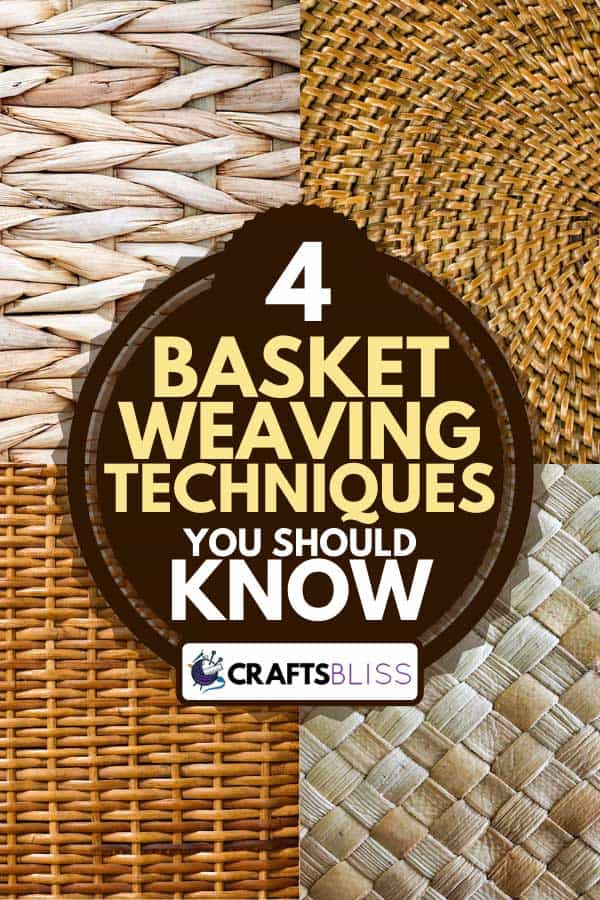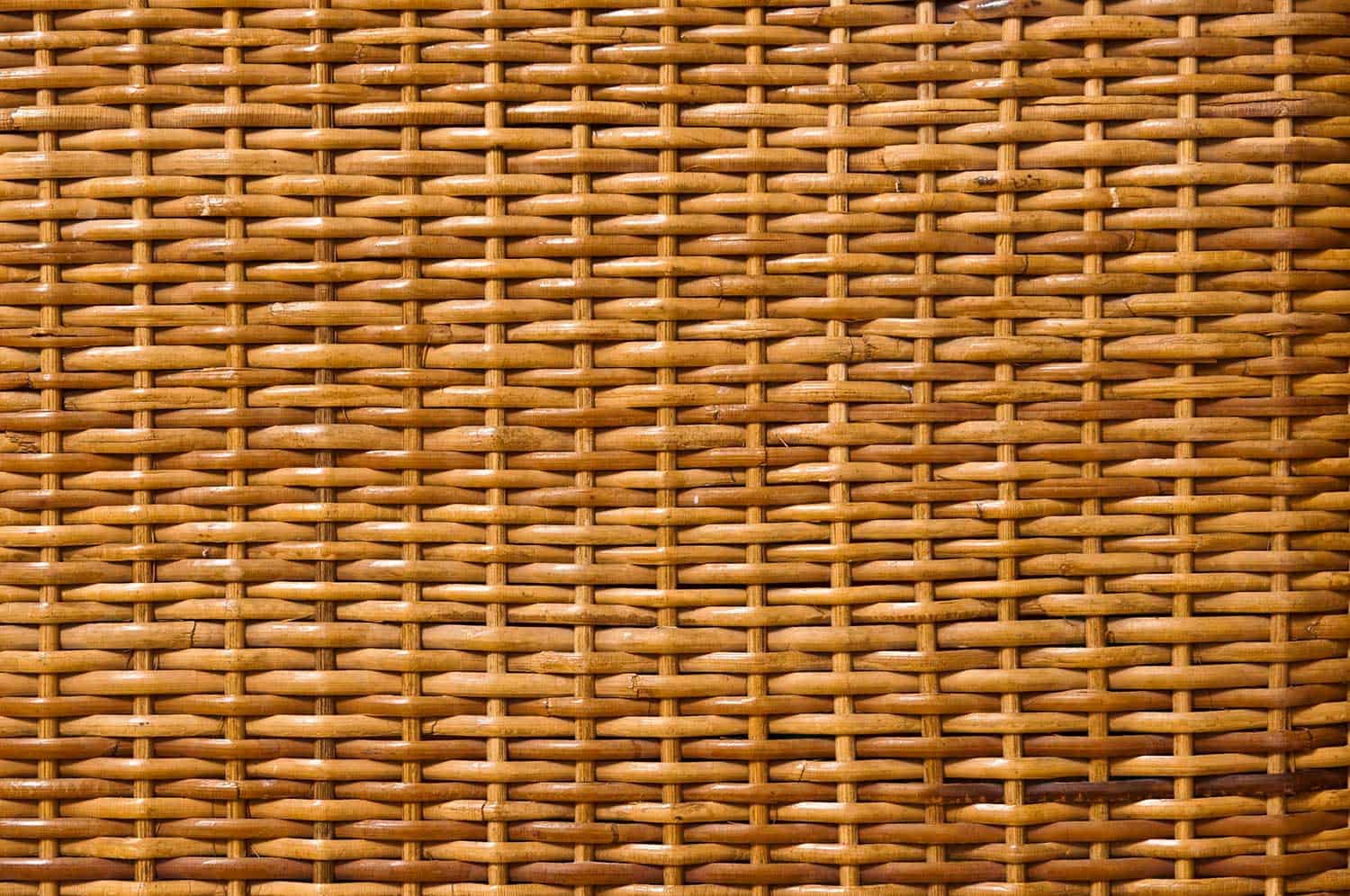Basket weaving is an art form that has been around for centuries. There are many techniques that can be used for making baskets, each with their own unique style. Here we break down the four most common basket weaving techniques.
If you are wanting to start basket weaving as a hobby or as a way to make additional income, the techniques you may want to try include:
- Plaiting
- Twining
- Wicker
- Coiling
Plaiting is the easiest technique for beginners to learn, while twining, wicker, and coiled baskets may take more practice in order to perfect. For a more in-depth look at each of the basket weaving techniques, continue reading!

Contents
Before You Get Started Weaving
Before you start basket weaving, there are terms specific to basket weaving that you will need to know. The terms staves and spokes refer to the “skeleton,” or frame, of the basket. A weaver refers to the material being woven.
Since basket weaving involves carefully weaving strands of a material over, under, or through a frame to create a unique shape, it is important to consider three questions before you begin making a basket.
- What is going to be the basket’s purpose?
- What do you want the size and shape of the basket to be?
- What materials are you going to use to make the basket?
The purposes of baskets include transportation, storage, and decoration. The purpose will determine the size and shape of the basket, as well as the best material and technique to use. You want your basket to be large and durable enough for its intended purpose.
When it comes to choosing a material for basket weaving, you have several options. It's important to keep in mind the flexibility and rigidity of materials, which is why it is important to know what kind of basket you are wanting to make before choosing a material.
If the material is too brittle, it cannot bend enough to be woven through the basket frame without breaking. If the material is too rigid, it won’t bend at all. Stiffer materials are usually used to create the frame for the basket, while more flexible materials are the ones that are usually woven throughout the frame. For each technique, we will look at the best types of materials to use.
The Four Techniques Of Basket Weaving
In this section, we'll go into more detail about each weaving technique.
Plaiting

Plaiting is the simplest basket weaving technique. The end result will typically be a flat, square, or rectangle-shaped basket. The leaves of tropical plants such as yucca or palm are the best materials to use for this technique. The leaves are woven together horizontally, vertically, or diagonally in an over-under pattern to create right angles, giving baskets made with this technique a checkerboard appearance.
There are two types of plaiting that you can use.
- Simple plaiting is woven to follow a pattern of over one, under one. This means that you weave the material over another material and under the next.
- Pattern plaiting is woven in a specific pattern. For example: over one, under two, meaning that you weave the material over another material, and under the next two. For pattern plaiting, you can also use two different colors of weavers.
Twining

Twining is a technique where two or more weavers are woven around spokes. When we hear spokes, we usually think of a wheel. Because of this, baskets that are made using this technique are usually round.
When creating this type of basket, one weaver goes in front of the spoke, and the other goes behind the spoke. The weavers are usually crossed over or twisted around each other in between spokes, so the type of material used for these baskets needs to be flexible, such as cedar bark, reeds, or roots.
It is important to pay attention to the orientation of the weavers while making the basket to make sure that the twist is consistent across the whole basket. To make the basket more unique, you can use two different colored weavers to create a pattern, or you can create variations in the basket by adjusting the tightness of your rows.
Wicker

Wicker baskets are the most difficult type of basket to make. The technique for creating a wicker basket is similar to twining because you start with spokes and weave the material around the spokes, but you do not have to cross the weavers over each other in between spokes.
Instead, the weavers are usually woven between the spokes in an alternating over one, under one pattern. By alternating, we mean that if the weavers are woven over one spoke and under the next spoke in one row, then on the row above, they will be woven under the spoke and over the next spoke. Wicker baskets can also have a series of two or three spokes that are being woven around, instead of just one.
Wicker baskets can be made out of any type of reed or grass, but the most common material used to make them is willow. Willow creates a more sturdy basket. The spokes are made of thicker, more rigid willow rods, while the weavers are made of thinner, more flexible willow rods.
Even though wicker baskets can be difficult to make, they are both beautiful and functional when finished. You can use a similar technique to create wicker furniture as well, once you have mastered the basket weaving technique.
Coiling

The last basket weaving technique is called coiling. This technique is technically not “weaving.” Coiling involves taking a “core” material and wrapping it, then sewing the materials together to create a spiral. Because of the spiral shape, coiled baskets are usually round when finished.
Common materials used for coiling are sweetgrass, pine needles, willow, or straw. For stitching the pieces together, a threadlike material such as palmetto, raffia, or horsehair is usually used.
Is Basket Weaving Hard To Learn?
As with anything new, basket weaving can be difficult at first. It's best to start with the simpler techniques and master them, then work your way up to the harder ones. As you create more baskets, the process will become easier.
Basket weaving kits are available for you to purchase. These will make basket weaving easier, less time-consuming, and cheaper for both beginners and experts.
Check out this basket weaving kit on Amazon.
How Long Does It Take To Weave A Basket?
It depends on the size of the basket. Small baskets can usually be completed in a day, while larger ones can take a week or two. Some techniques for basket weaving may take longer as well. The more complex the basket, the longer it will take to complete.
How Do You Weave A Round Basket?
For round baskets, the base of the basket will be similar to the frame of a wheel. Mark your spokes in the center, and arrange them in an overlapping, clockwise pattern so that the center lines are aligned to create a circle. Then, bend your base spokes upward and weave your weavers between the spokes according to the style of basket you want to create.
Check out this tutorial on how to weave a round reed basket:
How Do You Weave A Square Basket?
A square basket can have a base that is a square or a rectangle, and the base is usually made of flat materials that are woven in a way that resembles a checkerboard.
To create the base, lay 5 reeds parallel to each other and weave reeds perpendicular through them using the over one, under one pattern. Bend the base reeds upward, and weave more reeds through them using the same over one, under one pattern.
To craft the bottom of a square reed basket, follow along with this tutorial:
Can You Use A Basket Weave To Make A Placemat?
Yes! The plaiting technique has been used for centuries to create hats, mats, and bags by cultures of the Pacific Islands. Plaiting is the easiest and most commonly used method for making placemats, but other techniques can be used as well.
The simplest way to create a placemat is to create a square or rectangle base using a plaiting technique, without finishing the rest of the basket. You will want to make sure that your weave is very tight to prevent unraveling, and seal your placemat to make it easy to clean in case of a spill.
You're Ready To Start Basket Weaving!
Baskets have so many uses and there are so many options for what you can create. By breaking down each of the most common basket weaving techniques, we hope we made it easier for you to be able to start a new hobby, whether just for fun or to make a profit.
It takes practice to perfect any craft, but with practice, you will be on your way to creating baskets that are not only useful but beautiful as well!



![Read more about the article What’s The Best Glue For Fiberglass? [Our Top Products Explored]](https://craftsbliss.com/wp-content/uploads/2023/01/Worker-rolls-glue-solution-through-fiberglass-sheets-500x333.jpg)
![Read more about the article How Heavy Is Merino Wool [And How Many Pounds For A Blanket]?](https://craftsbliss.com/wp-content/uploads/2022/04/Pile-of-unprocessed-high-quality-colorful-alpaca-wool-500x333.jpg)
![Read more about the article Can You Glue Buttons To Fabric? [And How To]](https://craftsbliss.com/wp-content/uploads/2022/06/Four-buttons-of-a-suit-500x333.jpg)
![Read more about the article Is Glass Blowing Expensive? [Price ranges discussed]](https://craftsbliss.com/wp-content/uploads/2020/10/A-glass-blowing-artist-forms-a-blob-of-glass-into-a-vessel-using-a-gas-torch-500x333.jpg)

Do you know anything about repairing a bask that has become damaged at the top and the spokes are broken off along with the weaving?